Literature Review: Stufflebeam’s CIPP Model in Curriculum Evaluation
VerifiedAdded on 2023/06/18
|6
|1411
|193
Literature Review
AI Summary
This literature review examines the CIPP (Context, Input, Process, Product) evaluation model and its effectiveness in curriculum evaluation. The review highlights the model's ability to improve program quality in the education sector, emphasizing its four key elements. Context evaluation focuses on identifying needs and setting objectives, input evaluation concerns plans and strategies for implementation, process evaluation involves monitoring the implementation and providing feedback, and product evaluation measures both intended and unintended outcomes. The review draws upon several articles to illustrate the CIPP model's application in evaluating self-learning curricula for kindergarten, identifying areas for improvement such as integrating crucial skills like reading and writing. The CIPP model is presented as a valuable tool for educators to assess curriculum effectiveness, meet students' diverse needs, and make informed decisions about curriculum development and implementation. The study concludes that the CIPP model is a robust framework for enhancing educational quality by systematically evaluating various aspects of a curriculum.
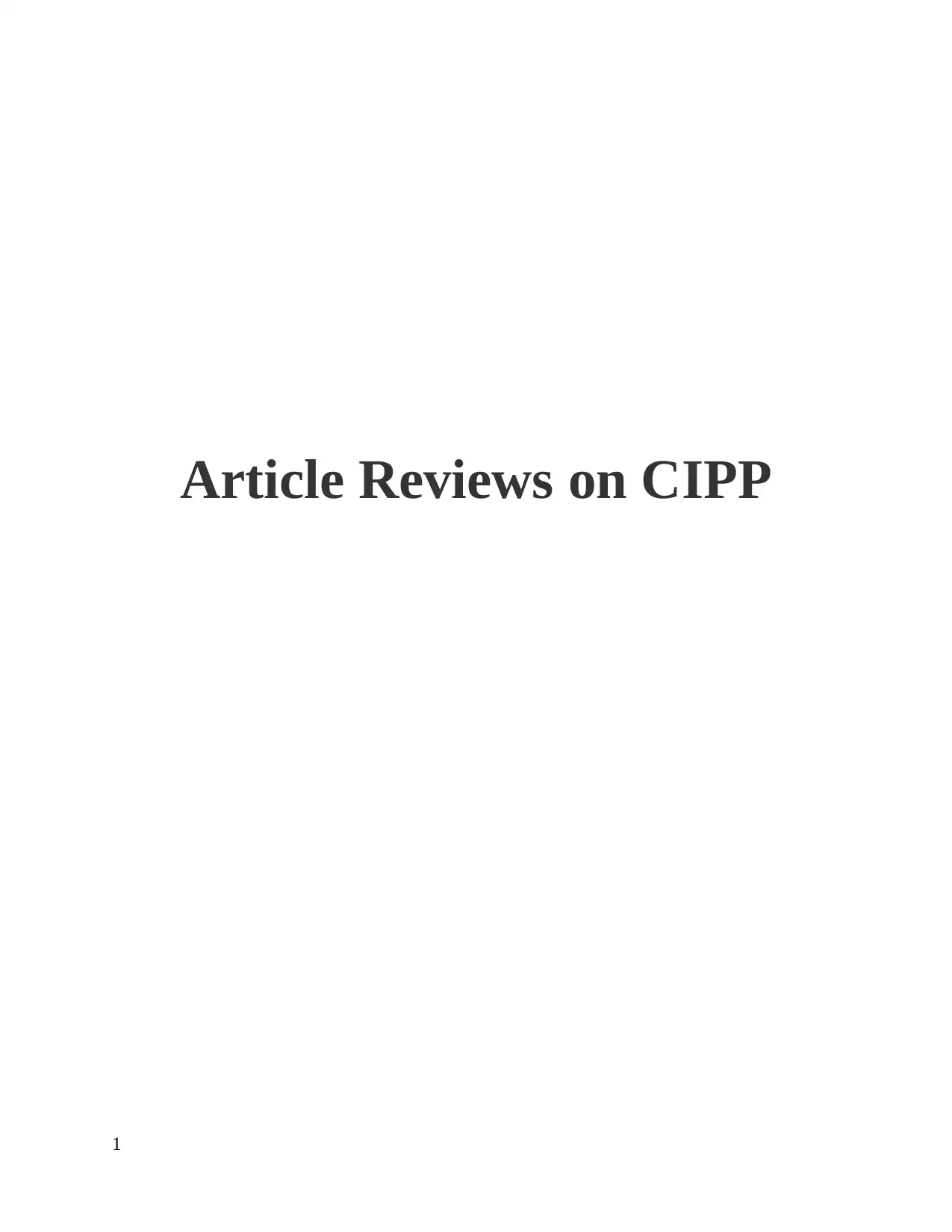
Article Reviews on CIPP
1
1
Paraphrase This Document
Need a fresh take? Get an instant paraphrase of this document with our AI Paraphraser

TABLE OF CONTENT
INTRODUCTION...........................................................................................................................3
Effectiveness of evaluation model CIPP model..........................................................................3
CONCLUSION................................................................................................................................5
REFERENCES................................................................................................................................6
2
INTRODUCTION...........................................................................................................................3
Effectiveness of evaluation model CIPP model..........................................................................3
CONCLUSION................................................................................................................................5
REFERENCES................................................................................................................................6
2
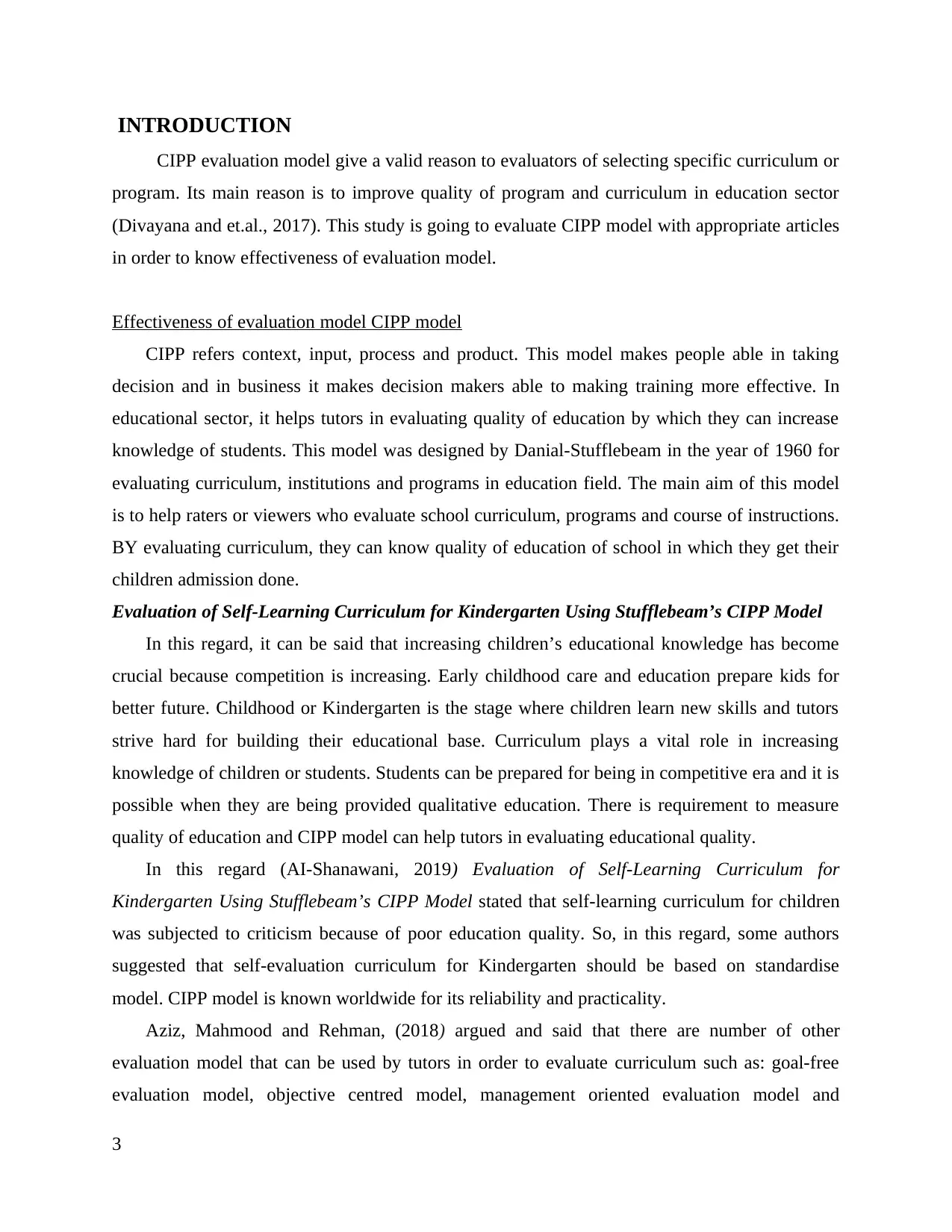
INTRODUCTION
CIPP evaluation model give a valid reason to evaluators of selecting specific curriculum or
program. Its main reason is to improve quality of program and curriculum in education sector
(Divayana and et.al., 2017). This study is going to evaluate CIPP model with appropriate articles
in order to know effectiveness of evaluation model.
Effectiveness of evaluation model CIPP model
CIPP refers context, input, process and product. This model makes people able in taking
decision and in business it makes decision makers able to making training more effective. In
educational sector, it helps tutors in evaluating quality of education by which they can increase
knowledge of students. This model was designed by Danial-Stufflebeam in the year of 1960 for
evaluating curriculum, institutions and programs in education field. The main aim of this model
is to help raters or viewers who evaluate school curriculum, programs and course of instructions.
BY evaluating curriculum, they can know quality of education of school in which they get their
children admission done.
Evaluation of Self-Learning Curriculum for Kindergarten Using Stufflebeam’s CIPP Model
In this regard, it can be said that increasing children’s educational knowledge has become
crucial because competition is increasing. Early childhood care and education prepare kids for
better future. Childhood or Kindergarten is the stage where children learn new skills and tutors
strive hard for building their educational base. Curriculum plays a vital role in increasing
knowledge of children or students. Students can be prepared for being in competitive era and it is
possible when they are being provided qualitative education. There is requirement to measure
quality of education and CIPP model can help tutors in evaluating educational quality.
In this regard (AI-Shanawani, 2019) Evaluation of Self-Learning Curriculum for
Kindergarten Using Stufflebeam’s CIPP Model stated that self-learning curriculum for children
was subjected to criticism because of poor education quality. So, in this regard, some authors
suggested that self-evaluation curriculum for Kindergarten should be based on standardise
model. CIPP model is known worldwide for its reliability and practicality.
Aziz, Mahmood and Rehman, (2018) argued and said that there are number of other
evaluation model that can be used by tutors in order to evaluate curriculum such as: goal-free
evaluation model, objective centred model, management oriented evaluation model and
3
CIPP evaluation model give a valid reason to evaluators of selecting specific curriculum or
program. Its main reason is to improve quality of program and curriculum in education sector
(Divayana and et.al., 2017). This study is going to evaluate CIPP model with appropriate articles
in order to know effectiveness of evaluation model.
Effectiveness of evaluation model CIPP model
CIPP refers context, input, process and product. This model makes people able in taking
decision and in business it makes decision makers able to making training more effective. In
educational sector, it helps tutors in evaluating quality of education by which they can increase
knowledge of students. This model was designed by Danial-Stufflebeam in the year of 1960 for
evaluating curriculum, institutions and programs in education field. The main aim of this model
is to help raters or viewers who evaluate school curriculum, programs and course of instructions.
BY evaluating curriculum, they can know quality of education of school in which they get their
children admission done.
Evaluation of Self-Learning Curriculum for Kindergarten Using Stufflebeam’s CIPP Model
In this regard, it can be said that increasing children’s educational knowledge has become
crucial because competition is increasing. Early childhood care and education prepare kids for
better future. Childhood or Kindergarten is the stage where children learn new skills and tutors
strive hard for building their educational base. Curriculum plays a vital role in increasing
knowledge of children or students. Students can be prepared for being in competitive era and it is
possible when they are being provided qualitative education. There is requirement to measure
quality of education and CIPP model can help tutors in evaluating educational quality.
In this regard (AI-Shanawani, 2019) Evaluation of Self-Learning Curriculum for
Kindergarten Using Stufflebeam’s CIPP Model stated that self-learning curriculum for children
was subjected to criticism because of poor education quality. So, in this regard, some authors
suggested that self-evaluation curriculum for Kindergarten should be based on standardise
model. CIPP model is known worldwide for its reliability and practicality.
Aziz, Mahmood and Rehman, (2018) argued and said that there are number of other
evaluation model that can be used by tutors in order to evaluate curriculum such as: goal-free
evaluation model, objective centred model, management oriented evaluation model and
3
⊘ This is a preview!⊘
Do you want full access?
Subscribe today to unlock all pages.

Trusted by 1+ million students worldwide
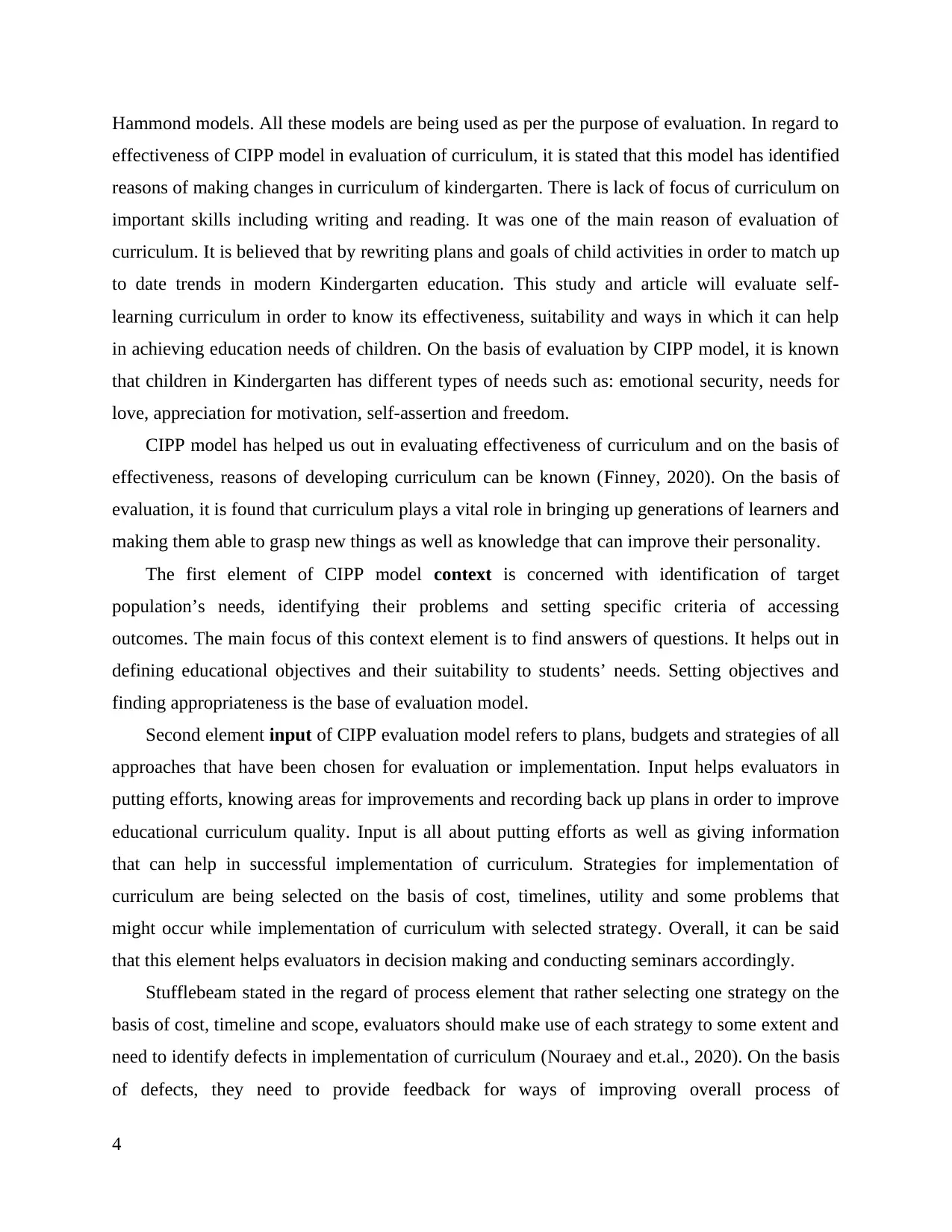
Hammond models. All these models are being used as per the purpose of evaluation. In regard to
effectiveness of CIPP model in evaluation of curriculum, it is stated that this model has identified
reasons of making changes in curriculum of kindergarten. There is lack of focus of curriculum on
important skills including writing and reading. It was one of the main reason of evaluation of
curriculum. It is believed that by rewriting plans and goals of child activities in order to match up
to date trends in modern Kindergarten education. This study and article will evaluate self-
learning curriculum in order to know its effectiveness, suitability and ways in which it can help
in achieving education needs of children. On the basis of evaluation by CIPP model, it is known
that children in Kindergarten has different types of needs such as: emotional security, needs for
love, appreciation for motivation, self-assertion and freedom.
CIPP model has helped us out in evaluating effectiveness of curriculum and on the basis of
effectiveness, reasons of developing curriculum can be known (Finney, 2020). On the basis of
evaluation, it is found that curriculum plays a vital role in bringing up generations of learners and
making them able to grasp new things as well as knowledge that can improve their personality.
The first element of CIPP model context is concerned with identification of target
population’s needs, identifying their problems and setting specific criteria of accessing
outcomes. The main focus of this context element is to find answers of questions. It helps out in
defining educational objectives and their suitability to students’ needs. Setting objectives and
finding appropriateness is the base of evaluation model.
Second element input of CIPP evaluation model refers to plans, budgets and strategies of all
approaches that have been chosen for evaluation or implementation. Input helps evaluators in
putting efforts, knowing areas for improvements and recording back up plans in order to improve
educational curriculum quality. Input is all about putting efforts as well as giving information
that can help in successful implementation of curriculum. Strategies for implementation of
curriculum are being selected on the basis of cost, timelines, utility and some problems that
might occur while implementation of curriculum with selected strategy. Overall, it can be said
that this element helps evaluators in decision making and conducting seminars accordingly.
Stufflebeam stated in the regard of process element that rather selecting one strategy on the
basis of cost, timeline and scope, evaluators should make use of each strategy to some extent and
need to identify defects in implementation of curriculum (Nouraey and et.al., 2020). On the basis
of defects, they need to provide feedback for ways of improving overall process of
4
effectiveness of CIPP model in evaluation of curriculum, it is stated that this model has identified
reasons of making changes in curriculum of kindergarten. There is lack of focus of curriculum on
important skills including writing and reading. It was one of the main reason of evaluation of
curriculum. It is believed that by rewriting plans and goals of child activities in order to match up
to date trends in modern Kindergarten education. This study and article will evaluate self-
learning curriculum in order to know its effectiveness, suitability and ways in which it can help
in achieving education needs of children. On the basis of evaluation by CIPP model, it is known
that children in Kindergarten has different types of needs such as: emotional security, needs for
love, appreciation for motivation, self-assertion and freedom.
CIPP model has helped us out in evaluating effectiveness of curriculum and on the basis of
effectiveness, reasons of developing curriculum can be known (Finney, 2020). On the basis of
evaluation, it is found that curriculum plays a vital role in bringing up generations of learners and
making them able to grasp new things as well as knowledge that can improve their personality.
The first element of CIPP model context is concerned with identification of target
population’s needs, identifying their problems and setting specific criteria of accessing
outcomes. The main focus of this context element is to find answers of questions. It helps out in
defining educational objectives and their suitability to students’ needs. Setting objectives and
finding appropriateness is the base of evaluation model.
Second element input of CIPP evaluation model refers to plans, budgets and strategies of all
approaches that have been chosen for evaluation or implementation. Input helps evaluators in
putting efforts, knowing areas for improvements and recording back up plans in order to improve
educational curriculum quality. Input is all about putting efforts as well as giving information
that can help in successful implementation of curriculum. Strategies for implementation of
curriculum are being selected on the basis of cost, timelines, utility and some problems that
might occur while implementation of curriculum with selected strategy. Overall, it can be said
that this element helps evaluators in decision making and conducting seminars accordingly.
Stufflebeam stated in the regard of process element that rather selecting one strategy on the
basis of cost, timeline and scope, evaluators should make use of each strategy to some extent and
need to identify defects in implementation of curriculum (Nouraey and et.al., 2020). On the basis
of defects, they need to provide feedback for ways of improving overall process of
4
Paraphrase This Document
Need a fresh take? Get an instant paraphrase of this document with our AI Paraphraser
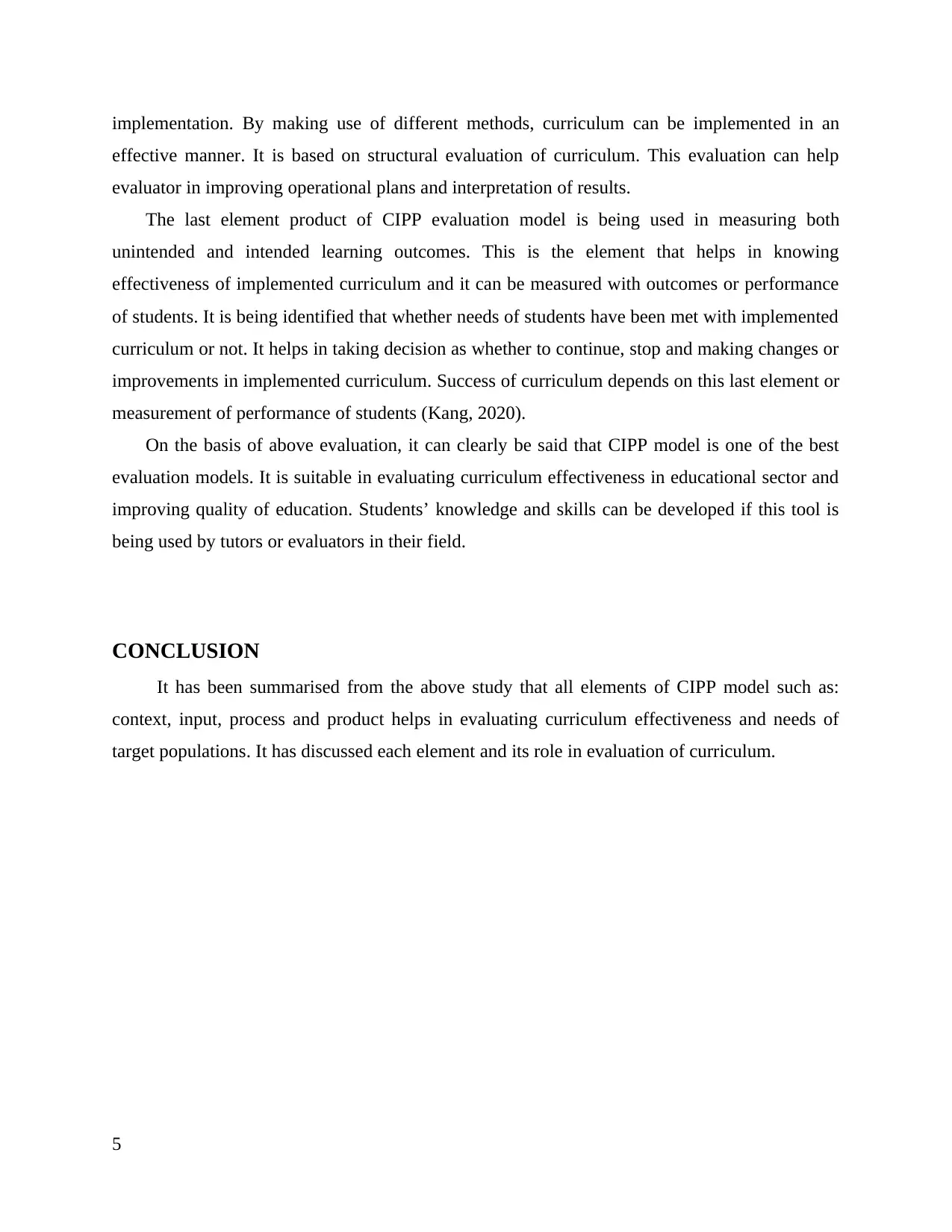
implementation. By making use of different methods, curriculum can be implemented in an
effective manner. It is based on structural evaluation of curriculum. This evaluation can help
evaluator in improving operational plans and interpretation of results.
The last element product of CIPP evaluation model is being used in measuring both
unintended and intended learning outcomes. This is the element that helps in knowing
effectiveness of implemented curriculum and it can be measured with outcomes or performance
of students. It is being identified that whether needs of students have been met with implemented
curriculum or not. It helps in taking decision as whether to continue, stop and making changes or
improvements in implemented curriculum. Success of curriculum depends on this last element or
measurement of performance of students (Kang, 2020).
On the basis of above evaluation, it can clearly be said that CIPP model is one of the best
evaluation models. It is suitable in evaluating curriculum effectiveness in educational sector and
improving quality of education. Students’ knowledge and skills can be developed if this tool is
being used by tutors or evaluators in their field.
CONCLUSION
It has been summarised from the above study that all elements of CIPP model such as:
context, input, process and product helps in evaluating curriculum effectiveness and needs of
target populations. It has discussed each element and its role in evaluation of curriculum.
5
effective manner. It is based on structural evaluation of curriculum. This evaluation can help
evaluator in improving operational plans and interpretation of results.
The last element product of CIPP evaluation model is being used in measuring both
unintended and intended learning outcomes. This is the element that helps in knowing
effectiveness of implemented curriculum and it can be measured with outcomes or performance
of students. It is being identified that whether needs of students have been met with implemented
curriculum or not. It helps in taking decision as whether to continue, stop and making changes or
improvements in implemented curriculum. Success of curriculum depends on this last element or
measurement of performance of students (Kang, 2020).
On the basis of above evaluation, it can clearly be said that CIPP model is one of the best
evaluation models. It is suitable in evaluating curriculum effectiveness in educational sector and
improving quality of education. Students’ knowledge and skills can be developed if this tool is
being used by tutors or evaluators in their field.
CONCLUSION
It has been summarised from the above study that all elements of CIPP model such as:
context, input, process and product helps in evaluating curriculum effectiveness and needs of
target populations. It has discussed each element and its role in evaluation of curriculum.
5
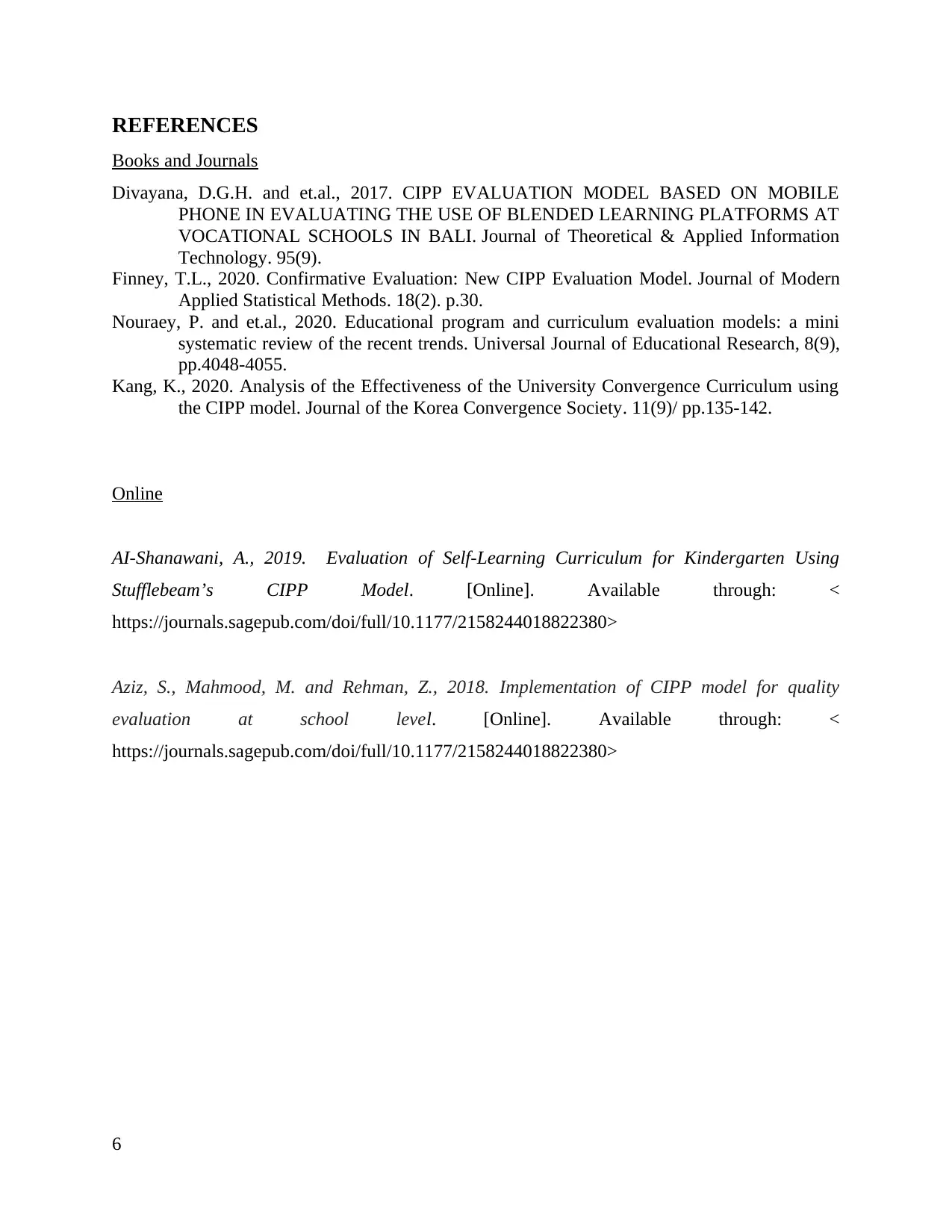
REFERENCES
Books and Journals
Divayana, D.G.H. and et.al., 2017. CIPP EVALUATION MODEL BASED ON MOBILE
PHONE IN EVALUATING THE USE OF BLENDED LEARNING PLATFORMS AT
VOCATIONAL SCHOOLS IN BALI. Journal of Theoretical & Applied Information
Technology. 95(9).
Finney, T.L., 2020. Confirmative Evaluation: New CIPP Evaluation Model. Journal of Modern
Applied Statistical Methods. 18(2). p.30.
Nouraey, P. and et.al., 2020. Educational program and curriculum evaluation models: a mini
systematic review of the recent trends. Universal Journal of Educational Research, 8(9),
pp.4048-4055.
Kang, K., 2020. Analysis of the Effectiveness of the University Convergence Curriculum using
the CIPP model. Journal of the Korea Convergence Society. 11(9)/ pp.135-142.
Online
AI-Shanawani, A., 2019. Evaluation of Self-Learning Curriculum for Kindergarten Using
Stufflebeam’s CIPP Model. [Online]. Available through: <
https://journals.sagepub.com/doi/full/10.1177/2158244018822380>
Aziz, S., Mahmood, M. and Rehman, Z., 2018. Implementation of CIPP model for quality
evaluation at school level. [Online]. Available through: <
https://journals.sagepub.com/doi/full/10.1177/2158244018822380>
6
Books and Journals
Divayana, D.G.H. and et.al., 2017. CIPP EVALUATION MODEL BASED ON MOBILE
PHONE IN EVALUATING THE USE OF BLENDED LEARNING PLATFORMS AT
VOCATIONAL SCHOOLS IN BALI. Journal of Theoretical & Applied Information
Technology. 95(9).
Finney, T.L., 2020. Confirmative Evaluation: New CIPP Evaluation Model. Journal of Modern
Applied Statistical Methods. 18(2). p.30.
Nouraey, P. and et.al., 2020. Educational program and curriculum evaluation models: a mini
systematic review of the recent trends. Universal Journal of Educational Research, 8(9),
pp.4048-4055.
Kang, K., 2020. Analysis of the Effectiveness of the University Convergence Curriculum using
the CIPP model. Journal of the Korea Convergence Society. 11(9)/ pp.135-142.
Online
AI-Shanawani, A., 2019. Evaluation of Self-Learning Curriculum for Kindergarten Using
Stufflebeam’s CIPP Model. [Online]. Available through: <
https://journals.sagepub.com/doi/full/10.1177/2158244018822380>
Aziz, S., Mahmood, M. and Rehman, Z., 2018. Implementation of CIPP model for quality
evaluation at school level. [Online]. Available through: <
https://journals.sagepub.com/doi/full/10.1177/2158244018822380>
6
⊘ This is a preview!⊘
Do you want full access?
Subscribe today to unlock all pages.

Trusted by 1+ million students worldwide
1 out of 6
Related Documents
Your All-in-One AI-Powered Toolkit for Academic Success.
+13062052269
info@desklib.com
Available 24*7 on WhatsApp / Email
![[object Object]](/_next/static/media/star-bottom.7253800d.svg)
Unlock your academic potential
Copyright © 2020–2025 A2Z Services. All Rights Reserved. Developed and managed by ZUCOL.





